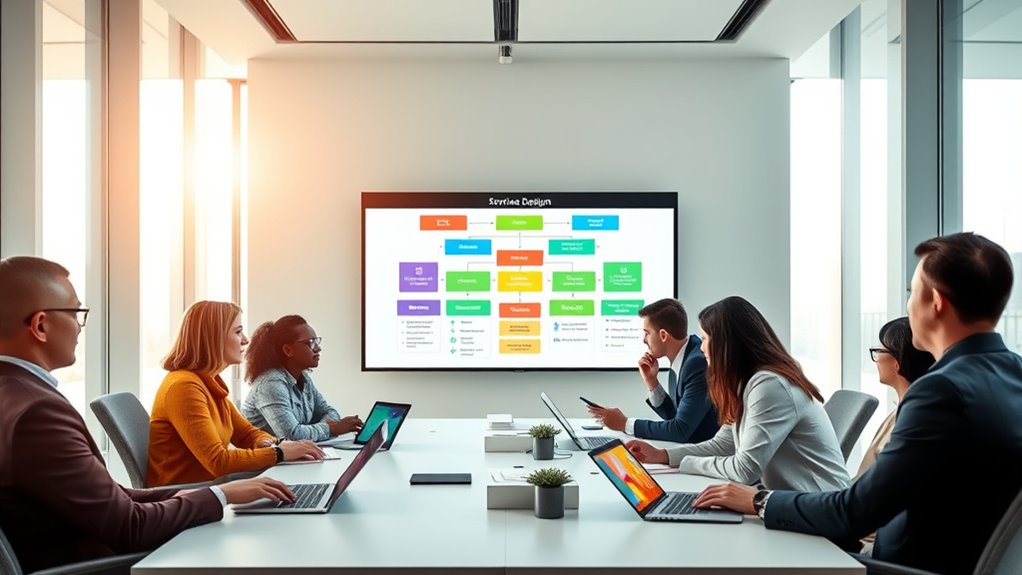Design thinking in government puts citizens’ needs at the forefront, encouraging collaboration and continuous improvement. By engaging stakeholders early, governments create policies that are more relevant and trusted. Rapid prototyping and iterative testing help refine services, making portals more accessible and user-friendly. Overcoming bureaucratic hurdles with agile methods fosters innovation. If you keep exploring, you’ll discover how these approaches lead to more effective, inclusive, and trustworthy digital public services.
Key Takeaways
- Design thinking fosters user-centered digital services by involving citizens in co-creation and continuous feedback.
- Prototyping and testing accelerate innovation, reduce risks, and improve service accessibility and inclusivity.
- Collaborative stakeholder engagement enhances policy relevance, builds trust, and ensures diverse needs are addressed.
- Agile methodologies enable government agencies to adapt quickly, iterate solutions, and overcome bureaucratic challenges.
- Measuring impact through clear metrics and lessons learned ensures sustained improvements in public digital services.
Embracing Empathy: Understanding Citizen Needs

How can government agencies truly serve citizens if they don’t understand what those citizens need? The answer lies in embracing empathy through community engagement and cultural sensitivity. When you actively listen to diverse voices, you gain insights into real challenges and aspirations. Engaging communities helps you see beyond assumptions, ensuring policies reflect actual needs. Recognizing cultural differences shapes more inclusive solutions, preventing misunderstandings or unintended consequences. Empathy isn’t just about kindness; it’s a strategic approach to designing better services. By prioritizing authentic dialogue and respecting varied backgrounds, you build trust and create meaningful impact. Understanding citizens deeply allows government to craft policies that are not only effective but also resonate on a personal level, fostering a more equitable and responsive public sector. Incorporating vibrational awareness techniques can further enhance understanding by tuning into the underlying feelings and attitudes of communities.
Co-Creation and Stakeholder Engagement in Policy Design

Effective policy design requires more than expert assumptions; it demands active involvement from diverse stakeholders through co-creation. You start by conducting stakeholder mapping to identify key groups, communities, and individuals impacted by or influential in the policy. This process guarantees no voice is overlooked and helps you understand different perspectives. Next, engage stakeholders through participatory workshops where they can share insights, express concerns, and contribute ideas directly. These workshops foster collaboration, build trust, and generate innovative solutions rooted in real needs. By involving stakeholders early and continuously, you create policies that are more relevant, accepted, and sustainable. This approach transforms policy development from a top-down process into a shared effort, ensuring that diverse voices shape effective public services. Incorporating stakeholder engagement into the process enhances the overall effectiveness and legitimacy of the policies.
Rapid Prototyping for Public Service Innovation

Building on stakeholder engagement, rapid prototyping accelerates the journey from ideas to tangible solutions in public service innovation. By quickly creating and testing prototypes, you can identify what works and what doesn’t, fostering sustainable innovation that aligns with public needs. This approach encourages policy experimentation, allowing you to refine concepts before large-scale implementation. Rapid prototyping reduces risks and costs, helping you learn early and adapt swiftly. It empowers you to gather real user feedback, ensuring the final service is user-centered and effective. Incorporating mobile responsiveness into prototypes ensures that services are accessible across all devices, which is essential for reaching diverse user groups. In government, this method promotes a culture of continuous improvement, enabling you to address complex challenges proactively. Overall, it’s a powerful tool to turn innovative ideas into practical, scalable public services that truly serve citizens.
Iterative Testing and Feedback Loops in Government Projects

Implementing iterative testing and feedback loops in government projects allows you to continuously refine services based on real user input. By establishing feedback loops, you gather insights directly from users, enabling you to identify issues early and adapt quickly. This ongoing process promotes emotional support, ensuring that public services better meet citizen needs. Regular testing of prototypes or service components lets you validate assumptions and make data-driven adjustments. Emphasizing feedback loops helps break down silos, fostering collaboration across teams and stakeholders. As you incorporate user feedback throughout development, the final product becomes more effective, accessible, and user-centered. This iterative approach reduces waste, increases efficiency, and builds trust with the public by demonstrating a commitment to responsive, transparent service design.
Digital Transformation of Public Service Portals

You can improve public service portals by focusing on user-centric design, making sure citizens find what they need easily. Streamlined navigation systems help reduce frustration and save time for users. When these elements come together, the digital experience becomes more efficient and accessible for everyone. Incorporating nutrient-rich ingredients into the design process can further enhance user engagement and satisfaction.
User-Centric Design
User-centric design is at the heart of transforming public service portals to better meet citizens’ needs. By actively gathering citizen feedback, you can identify pain points and preferences, *guaranteeing* the platform aligns with user expectations. Service personalization becomes possible when you tailor content and functionalities based on individual user data, making interactions more relevant and efficient. This approach encourages citizens to engage more confidently, knowing their voices influence service improvements. You can implement simple yet effective tools like surveys or feedback forms to continuously refine the portal. When citizens see their input reflected in the design, it fosters trust and satisfaction. Ultimately, user-centric design ensures public portals are accessible, responsive, and truly serve the people they’re meant to support.
Streamlined Navigation Systems
Have you ever struggled to find the information you need on a government website? Streamlined navigation systems improve your experience by simplifying the user journey. When navigation is clear and intuitive, you spend less time searching and more time accessing the services you need. These systems eliminate confusing menus and clutter, guiding you smoothly through relevant sections. By focusing on your user experience, government portals can prioritize key information and reduce frustration. Effective navigation design considers your goals and behaviors, making it easier to complete tasks efficiently. As a result, you’re more likely to trust the portal and return when needed. Incorporating user-centered design principles ensures the navigation system aligns with your needs and expectations. Streamlined navigation isn’t just about aesthetics; it’s about creating a seamless, accessible experience that meets your needs quickly and effortlessly.
Enhancing Accessibility Through User-Centered Design

Enhancing accessibility in government services requires designing with the diverse needs of all users in mind. You can achieve this by creating accessible interfaces that accommodate various abilities and preferences. Incorporate inclusive design principles to ensure everyone can easily access and navigate digital services. Consider users with visual, auditory, or motor impairments, and test your interfaces to identify barriers. By prioritizing usability and clarity, you make services more equitable and reduce frustration. User-centered design involves engaging real users early in the development process, allowing you to tailor solutions that meet their needs. An understanding of attention to detail ensures that every aspect of the interface is scrutinized for accessibility barriers, leading to more inclusive digital services. Ultimately, this approach fosters trust and inclusivity, ensuring government digital services are accessible to everyone, regardless of their individual circumstances.
Cross-Agency Collaboration and Design Sprints

When agencies work together, aligning their goals becomes essential for successful collaboration. Design sprints facilitate rapid prototyping, helping teams test ideas quickly and efficiently. By combining these approaches, you can accelerate innovation across government sectors and deliver solutions faster. Recognizing the importance of shared experiences and lessons, agencies can build upon successful strategies and foster a culture of continuous improvement.
Aligning Agency Goals
How can government agencies work together effectively to achieve common goals? The key lies in aligning policy and strategic objectives across departments. When agencies prioritize shared outcomes, you create a foundation for collaboration that reduces duplication and conflicting efforts. Clear communication of objectives ensures everyone understands their role in the bigger picture. Establishing common metrics and success criteria helps guide joint initiatives and maintains focus. By fostering policy alignment, you streamline decision-making and promote coordinated action. Regular check-ins and shared planning sessions reinforce commitment and allow adjustments as needed. This alignment not only accelerates progress but also builds trust among agencies, making cross-agency collaboration more efficient and impactful in delivering digital public services. Incorporating essential oils for stress relief during meetings can also improve teamwork and focus.
Rapid Prototyping Processes
Cross-agency collaboration accelerates innovation through rapid prototyping processes, such as design sprints, which enable teams to test ideas quickly and refine solutions in real time. To succeed, you need effective resource allocation, ensuring teams have the tools and time necessary for iterative development. Cultural adaptation plays a pivotal role; teams must be open to feedback and flexible in their approach across different agencies. These processes foster shared understanding and break down silos, allowing diverse perspectives to shape solutions faster. By focusing on rapid experimentation, you can identify issues early and adapt designs accordingly. This approach not only speeds up delivery but also builds cross-sector trust, making government services more responsive and user-centered. Ultimately, it empowers agencies to innovate collaboratively and efficiently. Incorporating design thinking principles helps ensure that solutions are user-centered and effectively address public needs.
Overcoming Bureaucratic Challenges With Agile Methods

Bureaucratic hurdles often slow down government innovation, making it difficult to respond swiftly to public needs. Bureaucratic inertia and compliance hurdles can stall progress, trapping initiatives in lengthy approval processes. To counter this, you can adopt agile methods that emphasize flexibility, collaboration, and iterative development. Agile approaches break projects into smaller, manageable tasks, allowing teams to adapt quickly and deliver value faster. By fostering cross-departmental communication and reducing rigid hierarchies, you can bypass traditional approval bottlenecks. This shift not only accelerates service delivery but also promotes a culture of continuous improvement. Embracing agile methods helps you navigate bureaucratic challenges, making government processes more responsive, efficient, and aligned with citizens’ evolving needs.
Measuring Impact and Success in Design-Led Initiatives

To gauge the success of your design-led initiatives, you need clear metrics that reflect meaningful progress. Monitoring long-term outcomes helps you understand sustained impact beyond immediate results, while aligning goals guarantees your efforts stay focused on desired societal changes. By focusing on these points, you can effectively measure and improve your government’s design efforts.
Defining Clear Metrics
Establishing clear metrics is essential for evaluating the success of design-led initiatives in government. You need to define performance benchmarks that reflect your goals and identify success indicators that demonstrate progress. These metrics provide concrete measures to determine if your efforts improve user experience or increase efficiency. Focus on specific, measurable outcomes relevant to your project’s objectives. For example, success indicators could include reduced processing times, higher user satisfaction scores, or increased accessibility. By setting these clear standards early, you create a framework for accountability and continuous improvement. Without well-defined metrics, it’s impossible to assess whether your design thinking approach truly delivers value or if adjustments are necessary to meet public needs effectively.
Monitoring Long-term Outcomes
How can you guarantee that the benefits of design-led initiatives in government persist over time? The key is ongoing monitoring of long-term outcomes through continuous policy evaluation. This process helps you track whether the initial improvements are sustained and identify areas needing adjustment. Engaging citizens regularly boosts civic engagement, ensuring that community feedback informs long-term success. By establishing clear benchmarks and collecting data over extended periods, you can measure impact beyond immediate results. This approach not only verifies that solutions remain effective but also builds trust and transparency. Ultimately, consistent monitoring and active civic participation enable you to adapt strategies, reinforce benefits, and ensure your initiatives deliver lasting value for the community.
Aligning Goals and Impact
Aligning goals with impact is essential for ensuring that your design-led initiatives achieve meaningful, measurable results. To do this effectively, you must focus on policy alignment and clear strategic objectives. When your project’s goals align with broader policies, you create a cohesive framework that guides progress and accountability. Define specific success metrics tied to your strategic objectives, making it easier to track progress and demonstrate value. Regularly review and adjust your approach to stay aligned with evolving policy priorities and user needs. This alignment helps prevent efforts from becoming isolated or disconnected from government priorities, ensuring your initiatives generate tangible, impactful outcomes that truly serve the public interest.
Lessons Learned and Future Opportunities in Public Sector Design

While the adoption of design thinking in the public sector has yielded valuable insights, it also reveals key lessons that can guide future efforts. Prioritizing public engagement is essential; involving citizens early ensures solutions are relevant and accepted. You should also embrace policy innovation by testing prototypes and iterating based on feedback, rather than relying solely on traditional procedures. Be prepared for resistance and learn to navigate bureaucratic challenges with patience and persistence. Recognize that successful public sector design requires cross-sector collaboration and transparency to build trust. Future opportunities include leveraging technology for more inclusive engagement and fostering a culture of continuous improvement. By applying these lessons, you can create more effective, user-centered public services that adapt to evolving needs.
Frequently Asked Questions
How Do Government Agencies Secure Funding for Design Thinking Initiatives?
You can secure funding for design thinking initiatives by exploring diverse funding sources like government budgets, grants, and partnerships. Start by demonstrating the value and potential impact of your project to justify budget allocations. Building strong cases for investment helps convince decision-makers to allocate resources. Additionally, tapping into innovation funds or pilot program budgets can provide targeted support, ensuring your initiatives receive the necessary financial backing to succeed.
What Training Is Needed for Public Servants to Adopt Design Thinking?
Imagine opening a new world where ideas flow like a river. To navigate this, you need empathy training to see from others’ perspectives and creative workshops to spark innovation. Public servants must learn these skills to embrace user-centered approaches, fostering collaboration and problem-solving. This training equips you to think outside the box, turning challenges into opportunities, and ultimately transforming public services into more responsive, effective solutions.
How Are Privacy Concerns Addressed During Citizen Co-Creation Processes?
During citizen co-creation processes, you should prioritize data privacy to protect personal information and maintain stakeholder trust. You can do this by implementing strict data handling protocols, anonymizing data when possible, and being transparent about how citizen input is used. Addressing privacy concerns openly reassures participants, encourages honest engagement, and guarantees that their rights are respected throughout the process, ultimately fostering a more effective and trusted collaboration.
Can Design Thinking Be Scaled Across Multiple Government Departments Effectively?
You might worry that scaling design thinking across government departments is too complex, but with strong interdepartmental collaboration, it becomes manageable. Embracing cultural change is essential, as it encourages openness and innovation. By fostering shared goals and communication, you can effectively implement design thinking across various agencies, leading to more user-centered policies and services. This approach ultimately enhances public trust and improves service delivery nationwide.
What Are Common Pitfalls in Implementing Design Thinking in Government?
When implementing design thinking in government, you often face pitfalls like bureaucratic resistance and stakeholder misalignment. These hurdles can stall progress if you don’t actively address the culture shift needed for innovative approaches. You might also encounter silos that hinder collaboration, making it difficult to fully embed design thinking. To succeed, you need to foster open communication, build trust among stakeholders, and demonstrate quick wins to counter resistance.
Conclusion
Think of government innovation like sailing a ship—you need to constantly adjust your course based on citizen feedback and changing tides. Embracing design thinking helps you navigate these waters smoothly, turning challenges into opportunities. By engaging stakeholders, prototyping quickly, and iterating often, you’ll steer public services toward greater impact. Just as a skilled captain learns from each voyage, your lessons today set the course for a more responsive, effective government tomorrow.









